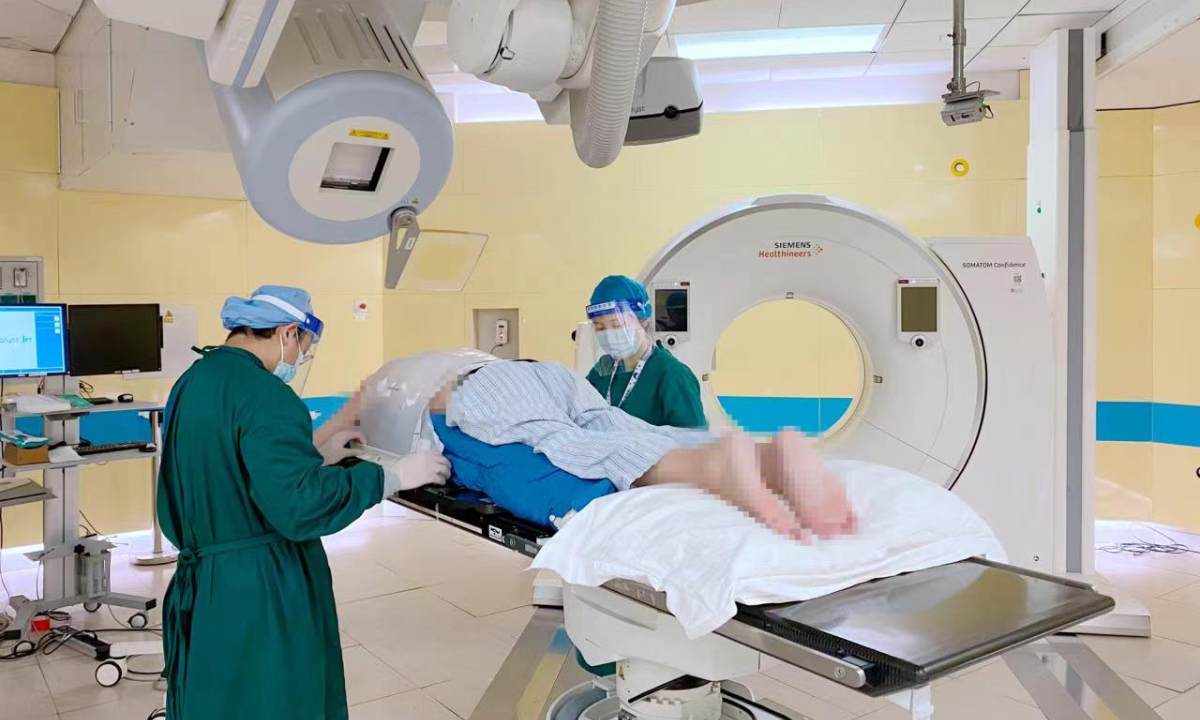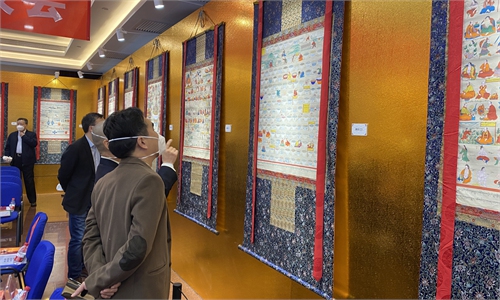China’s first hospital with heavy ion, proton radiotherapies sets new records for patients treated

A patient receives the heavy ion and proton radiotherapies at Shanghai Proton and Heavy Ion Center. Photo: Courtesy of Shanghai Proton and Heavy Ion Center
It can hardly be believed that the tidy and tranquil hall with people resting on the couches and sipping Starbucks coffee is the outpatient hall of Shanghai Proton and Heavy Ion Center, China’s first hospital specializing in using the international cutting-edge heavy ion and proton radiotherapy techniques to treat cancer and tumors.
The total cost is approximately 310,000 yuan ($45,018) including a flat rate of heavy ion and proton treatment cost (278,000 yuan), costs of hospitalization, medical examinations and nursing care, etc, which has not been increased since the hospital opened in 2015 in order not to increase the financial burden on patients, the Global Times learned from the hospital.
As of this month, the hospital has so far treated around 5,400 patients since its opening in May 2015, whereas institutions of the same kind in Germany and Japan where heavy ion and proton radiotherapies started earlier took up nine to 15 years to treat 5,000 patients. The hospital overcame unprecedented difficulties and challenges last year and saw a record number of 1,025 patients, exceeding 1,000 for the second consecutive year, which leads the annual patient treatment number among similar particle institutions in the world.
The hospital’s daily treatment of patients has climbed to over 90 and the number of patients treated and discharged from hospital in a single month has exceeded 100, both creating new records.
Nearly 75 percent of the patients treated at the hospital were diagnosed with a variety of cancers including nasopharyngeal carcinoma, intracranial and skull base tumors, lung, liver, prostate, pancreatic and breast cancer.
The hospital has explored innovations in clinical application and has expanded the indications of this therapy to over 40 kinds from the original seven.
The hospital has conducted more than 60 prospective clinical studies and practices, making breakthroughs in the treatment of some key diseases such as liver, lung and pancreatic cancers and reducing treatment fractions.
Usually, there are three kinds of treatment for tumors: radical treatment, adjuvant therapy and palliative treatment. The Global Times learned from the hospital, for some tumors, such as nasopharyngeal carcinoma, early stage prostate cancer and early stage lung cancer, heavy ion and proton radiotherapy can be used as radical treatment. For tumors with complex anatomy and tumors close to important tissues and organs with high surgical risks, such as intracranial and skull base tumors, heavy ion and proton radiotherapy has obvious advantages.
Statistics from the medical follow-up of the hospital show that the survival rates of cancer patients treated with heavy ion and proton radiotherapy techniques are generally higher than those treated with traditional photon radiotherapy, with much lower rates of side effects. In the case of nasopharyngeal carcinoma, for example, patients with recurrent nasopharyngeal carcinoma treated by the hospital with heavy ion therapy have substantially outperformed conventional photon radiotherapy in terms of efficacy and control of side effects. For highly malignant gliomas, the efficacy of treatment with heavy ion and proton proves to be better than that of the international standard STUPP regimen.
Over the years, the hospital has been providing medical services to patients from home and abroad. About one-third of the patients are from Shanghai while the rest are from across the country or from overseas countries or regions. So far, over 70 patients from foreign countries such as the US, the UK, France, South Korea and Singapore have been treated at the hospital.
With a wide range of indications, high tumor control rate and mild side effects, heavy ion and proton radiotherapy is increasingly gaining attention and recognition among cancer patients. Especially for elderly patients with underlying diseases, who cannot tolerate surgery and for people who do not want to choose invasive treatment, heavy ion and proton radiotherapy provides an ideal option of treatment.
During treatment, patients simply lie on the treatment bed and do not feel any discomfort. After being discharged, they are able to resume normal life soon afterward, which explains why more people are increasingly choosing heavy ion and proton radiotherapy.
Of course, the therapy also has its limits. At the moment, blood and stomach-related cancers for example, are not suitable for this treatment.
Although the treatment cost cannot be covered by the government-run medical insurance plan temporarily, it can be reimbursed by several commercial medical insurances, such as Huhuibao, a private budget supplement medical insurance for Shanghai residents.
Currently, there is an increasing demand for heavy ion and proton radiotherapy among patients. The hospital will continue to optimize the treatment process and to improve the treatment efficiency, so that the cutting-edge technology can benefit more tumor patients.



